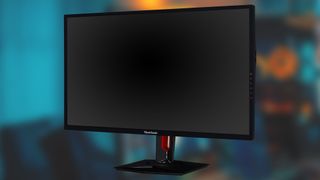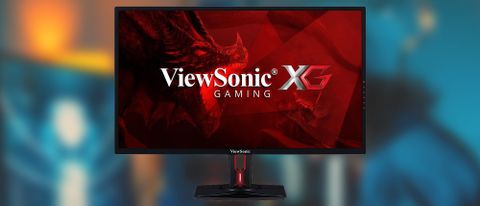Tom's Guide Verdict
The ViewSonic XG3220 offers plenty for gamers to love, from its 32-inch 4K screen to FreeSync and HDR10 support.
Pros
- +
Good-size 4K display
- +
Decent port selection
- +
AMD FreeSync for smooth gaming
- +
Superadjustable stand
Cons
- -
Limited to 60 Hz
- -
8-bit color only
- -
Weak speakers
Why you can trust Tom's Guide
The ViewSonic XG3220 ($449) is a 32-inch gaming monitor that's built for PCs and consoles alike, delivering a bunch of great features gamers will love, like 4K resolution, HDR support and FreeSync for seamless gaming at any frame rate. It's a solid gaming monitor in most respects, but the real selling point may be the price. For less than $500, you get not only a 32-inch gaming monitor but also amazing 4K resolution and plenty of gamer-friendly performance and features. Overall, the XG3220 is one of the best gaming monitors you can buy.
ViewSonic XG3220 design
There's a certain aesthetic that shows up on any product made for gamers. There will be lots of glossy black plastic, plenty of sharp, angular lines and usually a hefty serving of LED accent lights. The XG3220, however, manages to bring some restraint to the usual gaming design while still ticking all of these boxes.
The XG3220 manages to bring some restraint to the typical gaming monitor design.
The front of the monitor is quite plain, with the 0.5-inch bezels around the screen adorned only with a simple ViewSonic badge centered below the panel. The back of the monitor does indeed have some funky angles, with a pair of swooping boomerang-shaped insets that give the impression of a stylized X across the back of the monitor, but the angular design is mostly dressed in matte black, with glossy accents and red XG logos indicating that the monitor is part of ViewSonic's gaming line.

There is an RGB LED accent built into the stand, but it mostly serves as a power indicator, and another flash of red highlights a cutout hole for cable management. Also built into the stand is a fold-away hook for hanging a gaming headset when it's not in use.

The stand has plenty of adjustment options, from basics like tilt and side-to-side swivel to more ergonomic and productivity-minded adjustments, like height (with 4 inches of travel between the lowest and highest positions) and pivot to rotate the screen into portrait orientation.
And if you don't want the stand at all, the monitor can be used with a 100 x 100-millimeter VESA mount for hanging on the wall or attaching to the end of a monitor arm. The monitor alone measures 28.6 x 16.8 x 3.0 inches and weighs 11 pounds without the stand, so it should work well with any aftermarket mounting option that fits.
ViewSonic XG3220 ports and interface
On the back of the monitor you'll find a pair of HDMI 2.0 ports and a single DisplayPort 1.2 connection, along with a headphone jack for connecting headphones or speakers. These ports are all downward facing, which is a little inconvenient when you're reaching around to plug in headphones or another device, but otherwise, it isn't a problem. Also found on the back of the monitor is a USB 3.0 Type-A connection for hooking it up to your PC and two USB 3.0 ports. On the side you'll find two additional USB 3.0 ports, for a total of four.

Just below these ports, on the back side of the screen bezel, are buttons for adjusting the monitor settings and navigating the on-screen display. These six buttons provide quick access to power, settings menus, speaker volume and other adjustments.
ViewSonic XG3220 gaming performance
The XG3220 is built with gaming in mind, from the 3840 x 2160 resolution and 60-Hz refresh rate to the anti-glare hardcoat that keeps reflections off the screen.
The XG3220 is built with gaming in mind, from the 3840 x 2160 resolution and 60Hz refresh rate to the anti-glare coating.
Playing Hitman 2 on the XG3220, I was impressed by how well the higher resolution brings out the small details of a game. At a Florida racetrack filled with crowds and intricate environmental details, everything looked crisp and clear. Colors were also vibrant in the sun-drenched scenes.
However, once I viewed darker content, like the high-contrast color schemes of Ruiner, which is set in a shadowy, industrial cyberpunk world, it was obvious that dark colors looked a little washed out. Using the monitor's black stabilization settings, I was able to improve this appearance considerably, but since it is a backlit LCD, there was always a bit of glowing gray quality to the black portions of the display.
High-dynamic-range (HDR) content was better than the more pedestrian standard dynamic-range stuff, thanks to the monitor's HDR support, but it could have been better. Even though the monitor supports HDR10 for high-dynamic-range games and content, it achieves this through some software trickery, using dithering to make the 8-bit color look and act more like the 10-bit color needed for true HDR10 support.
The monitor handles fast action well, despite its 60-Hz refresh rate. When I was playing Ruiner, a fast-paced, top-down dual-stick shooter, the frenetic action looked great, without ever looking choppy. Would higher frame-rate support have been nice? Absolutely, but it would also result in a much more expensive monitor.
The monitor also boasts AMD FreeSync support, so matching GPU output to the monitor's refresh rate is dead simple and eliminates the tearing and judder you get when the panel and graphics card are out of sync.
ViewSonic XG3220 lab test results
While the ViewSonic XG3220 does cut some smaller corners in the name of affordability, it does so while still delivering decent performance and full 4K for UHD gaming.
The XG3220 performed well in our lab tests, starting with color. As measured by our Klein K-10A colorimeter, the display covers 149.7% of the sRGB color space, putting it ever so slightly ahead of the LG 38GL950G UltraGear (148.9%), much better than the Acer Predator X34 (98.9%) and a huge improvement over the older 24-inch ViewSonic XG2401 (91%), but it's still topped by the Samsung CHG70 (154.1%).
The XG3220 also has excellent color accuracy, with a Delta-E score of 0.08 (closer to zero is better). That's better than both the LG 38GL950G UltraGear (0.24) and the Acer Predator X34 (1.77), and even edges ahead of the Samsung CHG70 (0.09), though the two would appear identical, even to the trained eye.
The ViewSonic has slightly less impressive brightness, but with an average of 249.8 nits, it will still do the job just fine. While we saw portions of the screen reaching peaks of 299 and 300 nits, that overall brightness is a lot lower than we saw on the LG 38GL950G UltraGear (544.4 nits) and the Samsung CHG70 (364.8 nits), and it's still on par with the Acer Predator X34 (261 nits).
The XG3220's signal-to-screen latency of just 11 milliseconds is also pretty short. That's quicker than the 14.42-ms average for gaming displays. It should be quick enough that you never feel that it's slowing you down, even when you're enjoying quick, competitive games.
ViewSonic XG3220 modes and features
ViewSonic equips the XG3220 with a decent assortment of features, and that extends to the game modes that are built in.

Preset game modes are available for FPS, RTS and MOBA games, as well as for game consoles. There are also three custom options that can be dialed in to the exact settings you want for a specific game or use case. There's also a Gaming Lite mode, which reduces the amount of image processing to offer short lag times and faster responsiveness.
The XG3220's on-screen display also offers quick access to settings for contrast, color adjustments, input selection, volume control and deeper setup menus.
ViewSonic XG3220 audio quality
The XG3220 has a pair of built-in 5-watt speakers that provide stereo sound. They aren't particularly loud, and the sound can be a little tinny, but if you want to go without headphones during a gaming session, they should do the trick nicely.
Bottom line
The ViewSonic XG3220 manages to be two things at once. On the one hand, it's a pretty solid gaming monitor that boasts 4K resolution, FreeSync support and strong gaming performance. On the other hand, it sells for less than $500, making it substantially more affordable than many gaming monitors boasting similar features. The combination is a great blend of capability and price, especially for a spacious 32-inch panel.
While the XG3220 delivers plenty of bang for your buck, it does have some noticeable flaws, like the middling HDR performance and grayish-looking black levels, not to mention the fairly weak speakers. You can get better performance and richer color on monitors like the Acer Predator X34, but it's also substantially more expensive. But if you want 4K resolution for gaming on PCs and consoles, it's definitely one to consider, and it's our new favorite FreeSync monitor.
Brian Westover is currently Lead Analyst, PCs and Hardware at PCMag. Until recently, however, he was Senior Editor at Tom's Guide, where he led the site's TV coverage for several years, reviewing scores of sets and writing about everything from 8K to HDR to HDMI 2.1. He also put his computing knowledge to good use by reviewing many PCs and Mac devices, and also led our router and home networking coverage. Prior to joining Tom's Guide, he wrote for TopTenReviews and PCMag.


